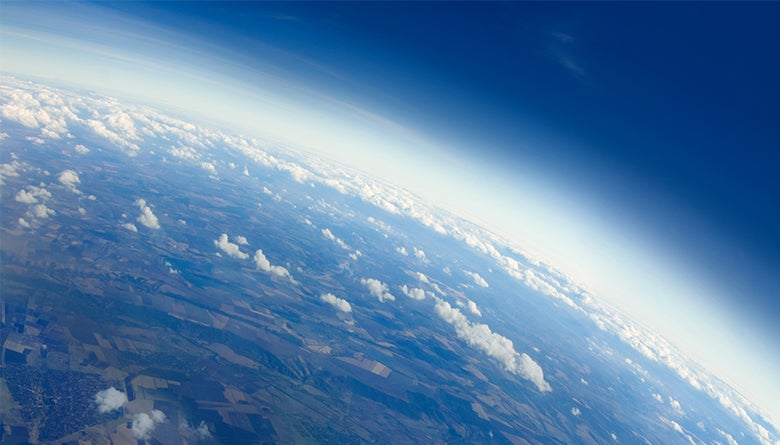
Author: Karyn Rogers
Assistant Professor of Earth and Environmental Sciences and Director of the Rensselaer Astrobiology Research and Education Center
How did life start on planet Earth? It’s a question that is very simple to ask, but much more difficult to answer because the chemical steps that led to life are largely unknown. Life likely emerged on this planet somewhere from 4 to 4.5 billion years ago. That time period is still known as the Hadean eon, taking its name from Hades, and conjuring images of a molten red hot surface, volcanoes, and violently destructive heat. For a long time, that’s what we thought early Earth looked like.
But thanks to decades of work by researchers like Bruce Watson of Rensselaer Polytechnic Institute, we now know that in that first half-billion years, Earth quickly developed the planetary characteristics we recognize today. This included the early formation of an atmosphere and ocean, although they had different compositions than they do now. The Hadean also likely saw the appearance of the continents and crust, and Earth’s magnetic field.
Earth was an interesting place for chemistry, and somewhere in that time period, chemical reactions, perhaps occurring in a sequence of varying environments, created a suite of prebiotic molecules that ultimately gave rise to life. But the exact sequence of environments, events, and chemistries remains a mystery.
In February, we announced that NASA’s Astrobiology Program awarded a team led by researchers at Rensselaer $9 million to tackle the question. The grant established the Earth First Origins project, and serves as the catalyst for launching the Rensselaer Astrobiology Research and Education (RARE) Center, part of NASA’s Prebiotic Chemistry and Early Earth Environments Consortium (PCE3).
Typically, scientists have tried to backtrack, examining modern life, identifying target molecules that we think to be essential for the emergence of life, and then trying to synthesize those molecules in the lab. The problem with targeting specific molecules in this way is that the conditions of synthesis that we optimize in the lab rarely look like the conditions that we would actually have found on the early Earth. Even if we can synthesize the target molecules for very specific scenarios for the origin of life, if we can’t find ways to synthesize those that are realistic for the planet, then we haven’t solved the problem of what prebiotic chemistry led to the emergence of life.
The Earth First Origins Project takes a different approach. We’re essentially agnostic as to which piece of chemistry is necessary for life to begin. Instead, we want to replicate the environments of early Earth in the lab as accurately as we can, and examine the chemistry they produce.
So rather than searching for a chemistry that we’ve pre-determined, we just want to understand the chemistry that the early Earth gave us, and then try to understand how that contributed to the emergence of life.
This approach, much like the question that induced it, sounds simple. But in practice it will involve dozens of researchers – Earth First Origins project is launching with 15 investigators from 10 institutions – and specialized tools and resources. The Earth First Origins teams is also part of this much larger PCE3 consortium, which is bringing together prebiotic chemists, early Earth scientists, and origins of life scientists from all over the world.
To support this work, the Earth First Origins project will establish the Gateway to Early Earth, which is both a physical lab space in the early Earth Lab (eEL) and a virtual environment, the Virtual early Earth Portal (VeEP), both housed at Rensselaer. The Gateway will be a resource for the Earth First Origins team, as well as the larger origins of life community, to access realistic early Earth environments, both experimentally and through models, and explore their potential to give rise to life’s chemistry.
The early Earth Laboratory will include a suite of experimental equipment used to replicate early Earth environments. The eEL will not only target the temperature, pressure, and geochemical conditions of the early Earth, but will also employ novel experimental techniques to represent the dynamic connections between different systems.
The VeEP provides applications and tools for integrating geochemical and geophysical models, and applying data visualization techniques to explore the range of possibilities in various early Earth environments. Additionally, the VeEP will allow researchers to record data from experiments, models, and analyses in “virtual notebooks” that are ingested into a larger structured data warehouse and accessed through the portal.
That sounds like a lot of new stuff, and it certainly will involve new work and new facilities. But the RARE Center, which supersedes the New York Center for Astrobiology, is continuing decades of astrobiology research at Rensselaer, which has a long history of doing prebiotic chemistry, early Earth geochemistry, extremophile biology, and the kind of data science that’s necessary to bringing it all together.
When we put all of our expertise and knowledge together, we’re hoping that we’ll be able to take a different look at early Earth, and see it from a new and hopefully revealing perspective.




